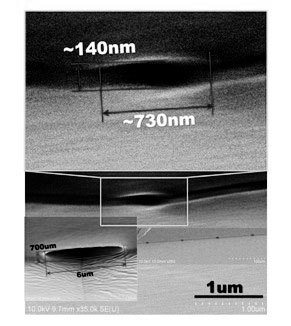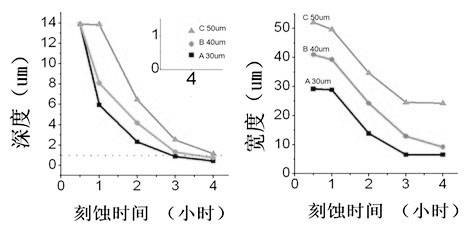Preparation method of polydimethylsiloxane micro-nanofluidic chip
A technology of polydimethylsiloxane and micro-nanofluidics, which is applied in the direction of photolithography, microstructure technology, optomechanical equipment, etc. Requirements for development, lack of simplicity of steps, repeatability and mass production of micro-nano processing alternative technologies, etc., to achieve highly repeatable results
- Summary
- Abstract
- Description
- Claims
- Application Information
AI Technical Summary
Problems solved by technology
Method used
Image
Examples
Embodiment 1
[0027] Example 1. Preparation of raised micro-nano structures on the glass surface
[0028] Step 1. In a dark room, the mask pattern is transferred to the chrome layer of the glass substrate through the UV exposure process, exposing for 0.5 minutes. Fix with a fixer (0.2% NaOH in water) for 2 minutes. Use a chrome removal solution (200g potassium dichromate and 35mL 98% acetic acid dissolved in 1L water) to remove the chrome layer outside the pattern. Remove excess photoresist with ethanol and dry.
[0029] Step 2. Put the treated glass into a constant temperature water bath (temperature 0°C), and over-etch the glass substrate with 1M etching solution for 10 hours.
[0030] Step 3. Take out the glass substrate, rinse and dry. corresponding micro-nanostructure
Embodiment 2
[0031] Example 2. Inverted mold preparation of PDMS micro-nanofluidic chip
[0032] Step 1. Mix the polydimethylsiloxane (PDMS) precursor and curing agent at a mass ratio of 3:1, pour it on the glass mold, and use a vacuum pump to remove air bubbles.
[0033] Step 2. Put the mold poured with the PDMS mixture in an oven and heat it at 40°C for 1 hour to cure the PDMS and peel it off from the glass mold.
[0034] Step 3. Treat the surface of the patterned PDMS sheet and the surface of the non-patterned PDMS substrate with oxygen plasma, and quickly attach them to obtain a polydimethylsiloxane micro-nanofluidic chip.
Embodiment 3
[0035] Example 3. Preparation of raised micro-nano structures on the glass surface
[0036] Step 1. Transfer the mask pattern to the chrome layer on the glass substrate through the UV exposure process, and expose for 5 minutes. Fix with fixer for 2 minutes. Use a chrome remover to remove the chrome layer other than the pattern. Remove excess photoresist with ethanol and dry.
[0037] Step 2. Put the treated glass into a constant temperature water bath (temperature 40°C), and over-etch the glass substrate with 1M etching solution for 1, 2, 3 and 4 hours respectively.
[0038]Step 3. Take out the glass substrate, rinse and dry. The corresponding micro-nano structure can be obtained, and the basic process monitoring and illustration of glass over-etching can be found in Figure 4 .
PUM
 Login to view more
Login to view more Abstract
Description
Claims
Application Information
 Login to view more
Login to view more - R&D Engineer
- R&D Manager
- IP Professional
- Industry Leading Data Capabilities
- Powerful AI technology
- Patent DNA Extraction
Browse by: Latest US Patents, China's latest patents, Technical Efficacy Thesaurus, Application Domain, Technology Topic.
© 2024 PatSnap. All rights reserved.Legal|Privacy policy|Modern Slavery Act Transparency Statement|Sitemap



